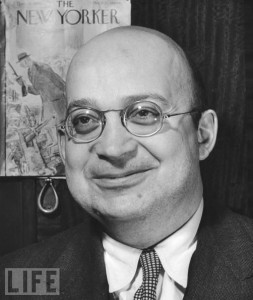February 3rd, 2013 § § permalink
The late, great journalist and press critic, A.J. Liebling, wrote the best book about dining (and Paris): Between Meals. He enjoyed many things besides food and drink (though he literally ate and drank himself to death). The Sweet Science reflects his love of boxing. The Jollity Building, The Honest Rainmaker and Earl of Louisiana are testimony to his fascination with raffish and outsize characters. He also had a nice habit of linking amorous pleasure with gustatory delight. He said the hearty eater thinking about the next fine meal is like the lover contemplating a future assignation. There is a threefold pleasure: Anticipation. Consummation. Reflection. HG thought about this as he opened a Fed Ex box from the wonderful Lower East Side smoked fish emporium, Russ & Daughters. It was packed meticulously and everything arrived in perfect condition. Smoked salmon. Sable. Salmon Caviar. Herring. Various fish salads. Cream cheese. Creme Fraiche. The bialys were a pleasant surprise. Oniony. Lightly browned. The real deal. When the last bialys from Russ were not gold standard, SJ admonished HG: “You don’t order herring from a bakery. You don’t order bialys from an appetizing store.” This batch of super-bialys proves SJ may be in error. As the chef/writer/television personality Anthony Bourdain has written: “Forget the Empire State Building, the Statue of Liberty…New York’s greatest living institution is very likely Russ & Daughters: A temple of uniquely New York deliciousness, Zen-like perfection and a repository of generations of wisdom and experience.”
Anyway. The Polish vodka is in the freezer. Anchor ale and Muscadet are in the refrigerator. All is in readiness for a David F. birthday party. Known as “The Dude,” (because of his resemblance to the protagonist of The Big Lebowski,) David F. is a bon vivant, novelist and former innovative educator. Should be a swell party. Meanwhile there is Anticipation. Consummation and Reflection will come later.

May 30th, 2012 § § permalink
Secret Ingredients: The New Yorker Book of Food and Drink, is an anthology from the pages of New Yorker Magazine and edited by David Remnick. In HG’s opinion, it is the best food book ever created. There are articles that will make you hungry (A.J. Liebling on the Paris restaurants of his youth; Joseph Mitchell on the old New York steak dinner or “beefsteak”; Joseph Wechsberg on French chef Fernand Point). Some will make you think (Adam Gopnik on French cuisine). Some will make you laugh (Calvin Trillin, Ogden Nash, Steve Martin, Dorothy Parker, Woody Allen and S.J. Perelman). Some may make you weep (Alice McDermott’s bittersweet fiction, “Enough,” on the varieties of appetite and desire). And, there’s one that may make you queasy. HG refers to “A Rat In My Soup” by Peter Hessler. The intrepid author visits Luogang, China, where two restaurants, The Highest Ranking Wild Flavor Restaurant and the New Eight Sceneries Wild Flavor Food City specialize in rat (yes, some tasty cat and snake dishes are also available). Hessler dines on Simmered Mountain Rat With Black Beans and Spicy and Salty Mountain Rat. He discovers, no surprise, that rat really isn’t very tasty. Anyway, “Secret Ingredients” is savory fare, indeed

July 26th, 2011 § § permalink
Cuisine plays a big role in the work of two writers of crime fiction — Rex Stout and Lawrence Sanders. Stout, the creator of the cerebral private investigator/gourmand, Nero Wolfe, gives the reader full accounts of the meals prepared by Wolfe’s chef, Fritz. Fritz was a master of haute cuisine and the intricate details provided by Stout were quite appetite provoking. At one point, Stout wrote and published a book of Wolfe’s favorite recipes which was never read by HG as HG is no fan of elaborate cuisine and time consuming kitchen procedures. Sanders, on the other hand, favored plebeian fare in his fictions. HG particularly likes the “wet sandwiches” constructed by one of his protagonists, Francis X. Delaney. Brimming with sardines, tomatoes, onions, etc., these tasty items have to be eaten over the kitchen sink to avoid general messiness.
Ach…how could HG leave out all of the excellent food that saturates Donna Leon’s Venetian mysteries? Ms. Leon’s protagonist, Commisario Guido Brunetti, sure likes his vittles. His wife, Paola, sets a delicious table for Guido and their children, Raffi and Chiara. HG rarely comes to the end of a Brunetti case without cooking up a batch of linguine aglio e olio (dusted with a nice batch of chopped parsley).
Far from the gritty, urban milieu of detective fiction, Laura Ingalls Wilder used to make young HG’s palate tingle with her descriptions of farm food in the “Little House On the Prairie” books. There were extensive descriptions of the preparation and eating of smoked venison, cured hams and, best of all, a simply mouth watering (and mighty mysterious to a young, Bronx Jew) exegesis on “Johnnycakes” flavored with pork cracklings. HG was not the only one riveted by Wilder’s descriptions. In Michael Ruhlman’s and Bran Polcyn’s great cookbook “Charcuterie: The Craft of Salting, Smoking and Curing” the two give Ingall’s “Little House In The Big Woods” much attention.
Alas, like a great tease, Georges Simenon’s Inspector Maigret pauses at many cafes and bistros in his yarns but there are no memorable mentions of food. (Many Parisian cafes and bistros claim to be the hangouts of the fictional sleuth).
Alan Furst, who specializes in spy thrillers set in Europe just before the beginning of World War Two, pays some attention to Paris brasserie food (particularly in his yummy descriptions of the fictional Brasserie Heinegger ) but his heroes seem more interested in sexual dalliance (taking excessive time out, in HG’s opinion, from their dangerous spy maneuvers) than serious noshing.
But, the best book about dining is the non-fiction “Between Meals: An Appetite For Paris,” A.J. Liebling’s memoir of his life in pre-World War Two Paris. Also worth reading are the various books by M.F.K. Fisher (pay no attention to her recipes–they are inferior). 


